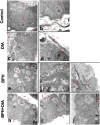Diacerein provokes apoptosis, improves redox balance, and downregulates PCNA and TNF-α in a rat model of testosterone-induced benign prostatic hyperplasia: A new non-invasive approach
- PMID: 37943844
- PMCID: PMC10635502
- DOI: 10.1371/journal.pone.0293682
Diacerein provokes apoptosis, improves redox balance, and downregulates PCNA and TNF-α in a rat model of testosterone-induced benign prostatic hyperplasia: A new non-invasive approach
Abstract
One of the most prevalent chronic conditions affecting older men is benign prostatic hyperplasia (BPH), causing severe annoyance and embarrassment to patients. The pathogenesis of BPH has been connected to epithelial proliferation, inflammation, deranged redox balance, and apoptosis. Diacerein (DIA), the anthraquinone derivative, is a non-steroidal anti-inflammatory drug. This study intended to investigate the ameliorative effect of DIA on the prostatic histology in testosterone-induced BPH in rats. BPH was experimentally induced by daily subcutaneous injection of testosterone propionate for four weeks. The treated group received DIA daily for a further two weeks after induction of BPH. Rats' body and prostate weights, serum-free testosterone, dihydrotestosterone, and PSA were evaluated. Prostatic tissue was processed for measuring redox balance and histopathological examination. The BPH group had increased body and prostate weights, serum testosterone, dihydrotestosterone, PSA, and oxidative stress. Histologically, there were marked acinar epithelial and stromal hyperplasia, inflammatory infiltrates, and increased collagen deposition. An immunohistochemical study showed an increase in the inflammatory TNF-α and the proliferative PCNA markers. Treatment with DIA markedly decreased the prostate weight and plasma hormones, improved tissue redox balance, repaired the histological changes, and increased the proapoptotic caspase 3 expression besides the substantial reduction in TNF-α and PCNA expression. In conclusion, our study underscored DIA's potential to alleviate the prostatic hyperplastic and inflammatory changes in BPH through its antioxidant, anti-inflammatory, antiproliferative, and apoptosis-inducing effects, rendering it an effective, innovative treatment for BPH.
Copyright: © 2023 Rasheed et al. This is an open access article distributed under the terms of the Creative Commons Attribution License, which permits unrestricted use, distribution, and reproduction in any medium, provided the original author and source are credited.
Conflict of interest statement
The authors have declared that no competing interests exist.
Figures







References
-
- Trujillo-Rojas L, Fernández-Novell JM, Blanco-Prieto O, Martí-Garcia B, Rigau T, Rivera Del Álamo MM, et al.. Rat age-related benign prostate hyperplasia is concomitant with an increase in the secretion of low ramified α-glycosydic polysaccharides. Theriogenology. 2022;189: 150–157. doi: 10.1016/j.theriogenology.2022.06.011 - DOI - PubMed
Publication types
MeSH terms
Substances
LinkOut - more resources
Full Text Sources
Medical
Research Materials
Miscellaneous

